The World and the Fat Mountain
From Sakai to Shinodayama along the Kumano Kodo Kii-ji route
世界
The river in the picture had been hopefully painted in a deep blue, but looking down at the real thing, it seemed more like the Amazon – a pale greenish-brown. Nevertheless, turtles bobbed their orange-flashed heads and fish swam just beneath the surface. Crossing the Ishizu River was a bridge that announced itself as a transit point for the Kumano Kodo with Seville-style ceramic plaques showing groups of pilgrims plodding onward on foot and horseback to Kumano. Behind the huge signboard that advertised new apartments with happy strolling people, I found two temples I was looking for: the first, Daianji Temple, was surrounded by walls of deep ochre baked earth and layered grey tile. It is reputed to have once been the residence of a wealthy Sakai merchant from the sixteenth century. The neighbouring Nanshuji Temple was built in the mid-1600s and includes a ‘dry garden’ made with rocks and sand, which I thought typically Japanese, yet the paintings inside and gateway to the temple seemed very Chinese.
From the spiritual I left for the temporal, the Kumano Kodo passed through numerous warehouses, lots of medium-size specialist manufacturing companies — the equivalent of Germany’s Mittelstand. I’ve never seen areas like this in England, lots of small warehouses and workshops with people busily cutting metal. There are signs advertising workshops to rent, men in overalls with rolled towels tied around their heads and behind half-closed doors the flying sparks of acetylene torches.
Rising above these warehouses, when I looked towards the coast, three cranes rose in a fleur-de-lis. They were putting the finishing touches to a new LCD television plant for Sharp on the reclaimed land next to Osaka Bay. The bay was about to become LCD bay – Japan’s new specialist site for television production. But by the time I finished my pilgrimage to Kumano, those dreams were over — the bottom had dropped out of the market — intense competition from Korean and Chinese companies and a shift to smaller screens for smartphones. One production facility around the bay was forced to close and this one in Sakai became half-owned by a Taiwanese company. Sharp, whose headquarters are here in Sakai, teetered for a while on the brink of bankruptcy.
The frequent stone marker posts along this section of the ancient road seemed out of place against the background of reversing trucks, chain-link fence and beeping fork-lifts. On one side I passed a big Shimano factory (ever wanted to know where your bicycle gears are made?). All the gunsmiths in Sakai after the civil war boom period had other skills that could be put to more peaceful ends. Their techniques were used in the repair of imported bicycles and helped create a bicycle parts industry. It’s a classically Japanese story: import, copy, and then export to the rest of the world.
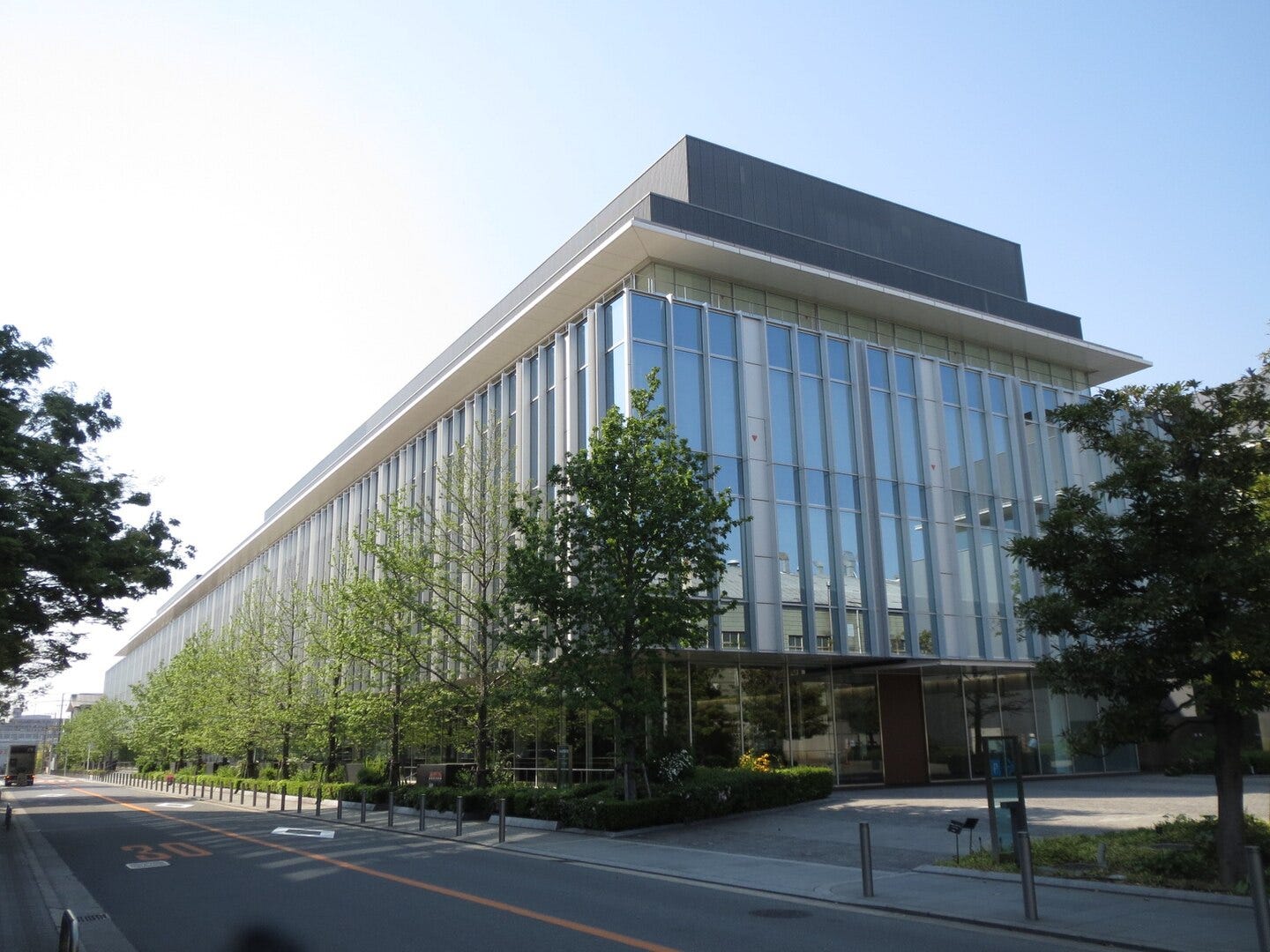
Tucked away down the backstreets was another example of more peaceful exchange with the outside world — the konpeito factory. Konpeito is derived from the Portuguese word for sweets — the Portuguese brought refined sugar here too. A quick factory tour showed the history of konpeito and the different kinds of sugars. Then, it was on to the making — sugar was poured into a revolving drum where it was heated, dye was added and gradually it came together in lumpy balls. These lumpy balls are the konpeito, a hard crunchy sweet, a bag of which I stuck in my rucksack for my journey.
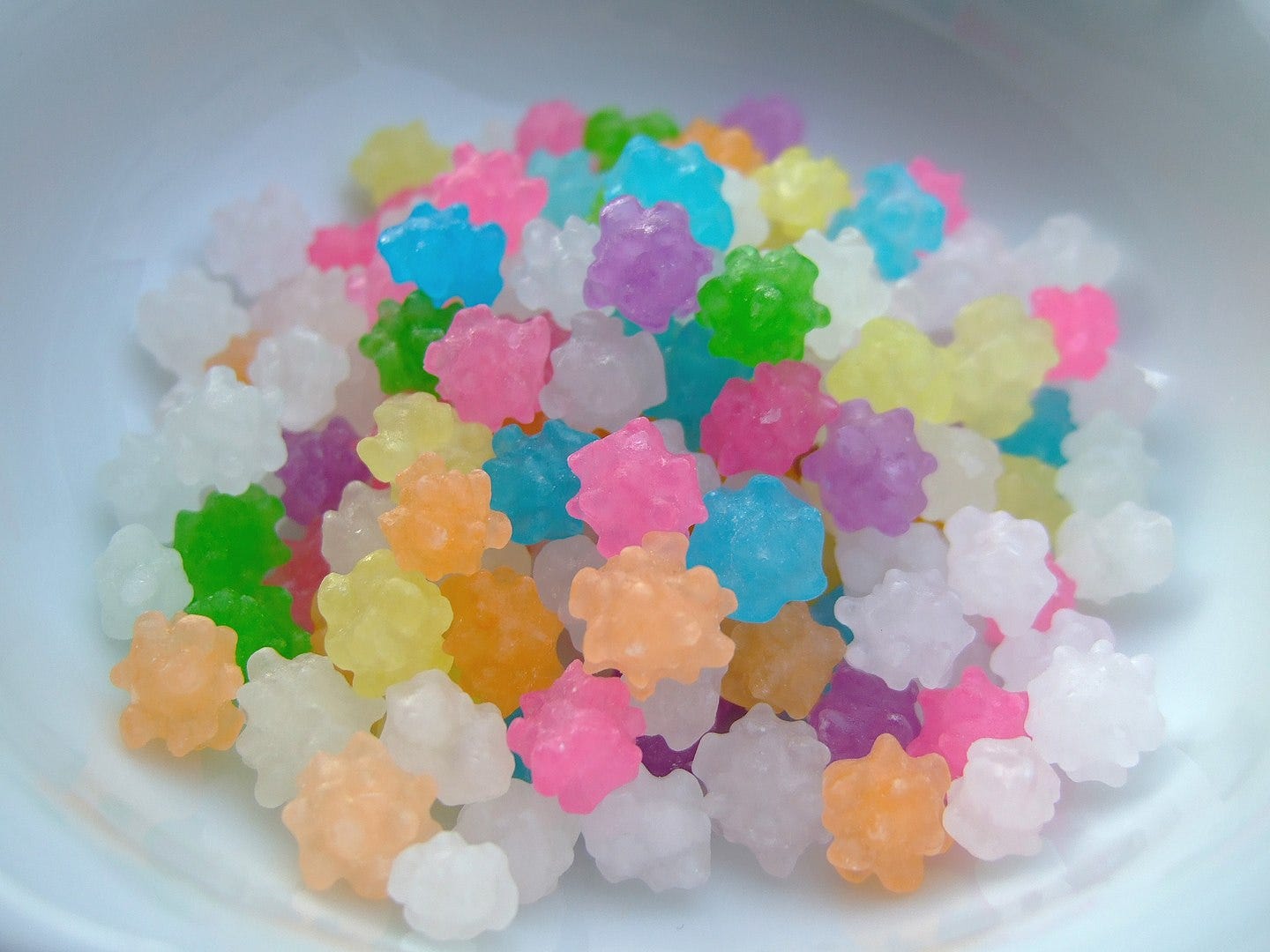
Osaka and its suburbs are best viewed from two levels. First, you have to get down to the street level, divert from the main thoroughfares and find the little hidden shrines, tumuli and old housing that you otherwise rarely see. Second is from an elevated expressway, from here you can see over the sea of concrete boxes and see the lie of the land that is hidden from street level. With so many buildings it is often difficult to see why parts of Japanese cities are named the way they are. Japanese towns usually have simple descriptive names like Koyamamachi (Little Mountain Town) which leave you puzzled: where is the mountain? But from the elevated expressway all becomes clear: ah there it is — it really is a small mountain!
Those elevated expressways served a second useful purpose; I stood under one now, sheltering from the summer sun and trying to work out my way onward. After a little wandering around, I found a broad muddy river and regained my bearings. A dinosaur was trying to chew the roof off a neighbouring building next to the bridge I crossed as I wondered why it was the Japanese seemed to have little sense of what was tacky — cafes here advertise they’re open with the flashing orange lights you see on garbage trucks in the UK.
I had become addicted to coffee-milk. This was an extremely sweet milky substance with only a passing resemblance to actual coffee. In the cool of my house the drink tasted fantastic. Now I bought a carton of this fabulous concoction from one of the millions of convenience stores that cover Japan. Somehow out in the hot sun and drinking through a straw it didn’t taste nearly as good. In fact it was positively sickly, so it was with some relief that I finished it and carefully sucked up the last drops so it wouldn’t leak in my bag. I considered putting the empty carton in a plastic bag to make doubly sure it wouldn’t leak. I dismissed the idea.
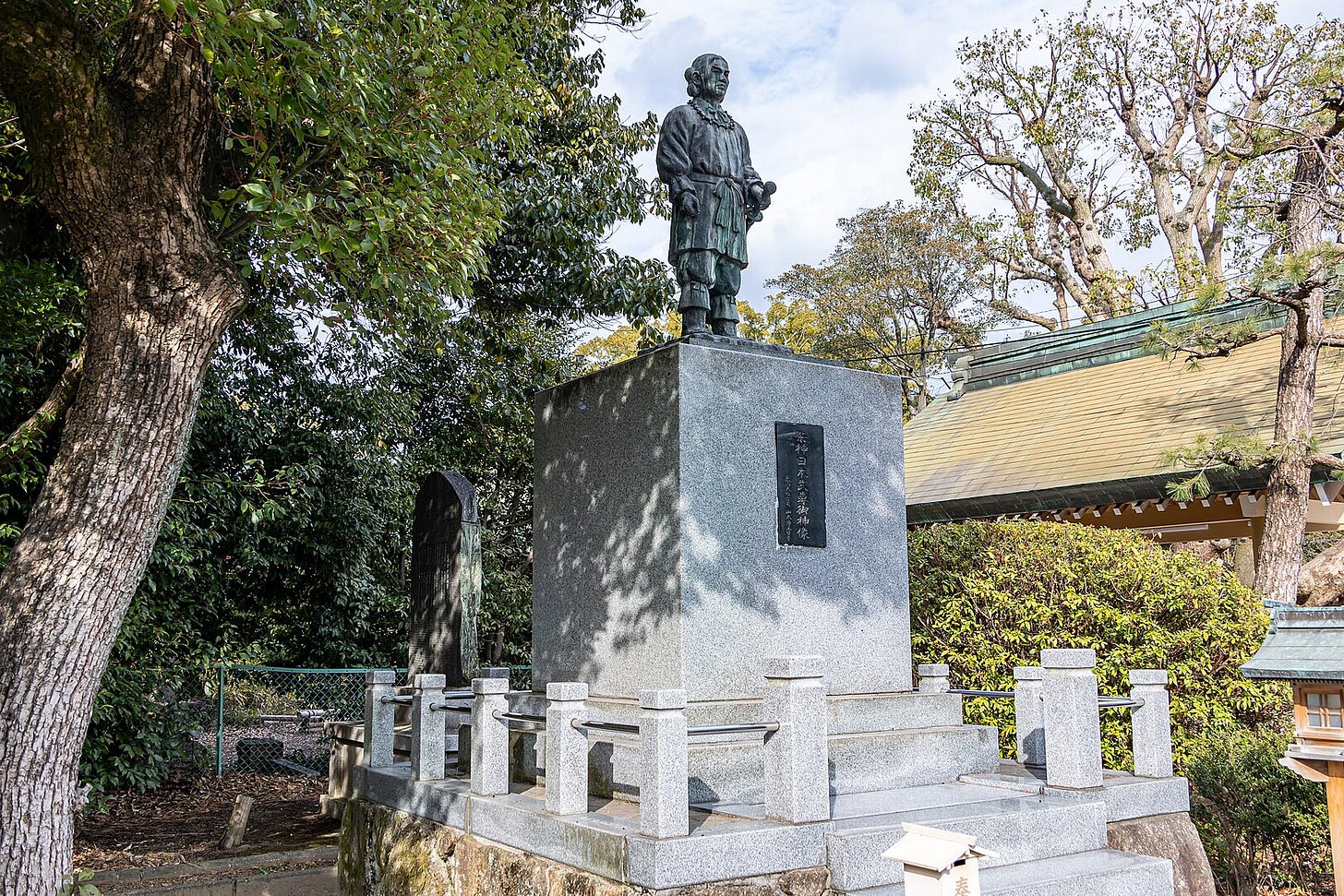
I was approaching Otori Shrine when I felt the back of my leg was wet. Probably just sweat. I looked to make sure. There was a long splash of diarrhoea-like dribble running down the back of my left leg. I took my rucksack off; coffee-milk was dripping from the bottom of the bag. I spent my time at Otori Shrine frantically trying to dry off the stain and hoping that I wasn’t giving foreigners a bad name as people so dirty they would rather go in their own pants than use a toilet.
It was time to go home.
The Trusty Fat Mountain 信太山
The next day I set off from Otori with clean trousers and a sunburned nose. The ‘high nose’ that the Japanese so admire had caught the sun with unfailing regularity the previous day. The Kumano Kodo sent me through a long shoutengai shopping centre that curved through the suburbs of Otori like a samurai sword . The shoutengai is the equivalent of the British high street, long rows of supposedly charming and unique small shops threatened by big anonymous out-of-town shopping centres where kids can have fun. They differ from British high streets in that they were designed from the outset for pedestrians and they have a roof. The roof makes them seem dingy and smelly, fish shops mixed with clothing and bookstores are a good way to keep the young fashionistas away. And stay away they do: they are almost entirely frequented by Osaka obasans, the sharp-elbowed, wobbly bicycle-riding, animal-print-coat-wearing grandmothers that are an Osaka stereotype.
I was immediately lost. I misread my map (this would become an enduring feature of my walk) and turned away from the Kumano Kodo and towards the east with its long jagged line of mountains. These mountains are known as the Kongou Sanchi, which according to my rough translation meant ‘hard golden mountains’. These mountains form the eastern edge of the coastal plain on which Sakai and Izumi cities sit.
I realised my error and began to backtrack westward towards the route of the Kumano Kodo. On the way past a school sports field I crested a rise and found myself among rustling fields of green immature rice. The rice had a smell — overtones of fragrant aniseed with undertones of sodden mud and submerged snails. For a moment, just a moment, I was able to appreciate what this area must have been like for the pilgrims of old. I had a good view across the emerald fields to the hazy outline of the mountains behind Kobe on the other side of Osaka Bay. I was brought back to the present day by the sound of clinking, breaking glass at a recycling plant on my left.
I rediscovered the route of the Kumano Kodo by a main road skirting the rear of a residential area, and once again had to take shelter from the burning sun beneath a motorway overpass. In the cool shade I figured out the route and continued on into an area of old housing.
Lots of foreign visitors to Japan say that the country doesn’t have many old houses. When I first arrived in Japan, I thought so too. The Kumano Kodo would change that impression. The reason for the misimpression, I came to believe, is that old Japanese houses are tucked away in the centre of towns, surrounded by modern suburbs, like the red bean paste tucked away in the centre of the Japanese anpan bread. As time has passed, the commercial centre of the town has moved away from these old areas, with their narrow streets unsuitable for motor cars, and shifted to more modern car and public transport-friendly areas. So, in most areas, the old houses are left adrift in featureless suburbs far from tourist eyes.
Japanese old houses are typically wooden-framed, with the square gaps in the wooden frame filled with white straw-bound earth pasted over a bamboo wattle. In design they somewhat resemble the English country houses that were built more than 500 years ago — a wooden frame with a wattle and daub filling. Indeed, sometimes, especially in more rural areas I got a distinctly rustic English sensation from wandering among these old houses.
One difference from old English country houses is that the lower half of the houses are clad in darkened wooden vertical panels which reminded me of the interior of the Methodist church I went to as a child. Their roofs are covered with gunmetal grey curving tiles that shine like a winter sea. The eave tiles have smooth rounded ends like the heads of worn nails, or older tiles sometimes have a decorative pattern on them like a child’s toy rubber stamp. The roof ridges are built up with layers of thin ridge tiles. Typically larger houses have more pronounced ridges than smaller ones. Some houses are surrounded by walls topped with more tiles over which you can see the bristly ovals and twisted, gnarled branches of ornamental pines.
In the midst of this old part of town I stopped and bought some water from a vending machine, I stood awkwardly drinking it under the only shade available, provided by a garden wall in a little side-street. I looked stupid, I was sure, a foreigner standing by himself in the midday heat. I was now entering the district of Shinoda and aiming for Shinoda’s oji. There appeared to be nothing left of the actual oji shrine save a stone marker post next to a small park.
It was time to ascend the trusty fat mountain – Shinodayama (my literal translation of the kanji). From ground level this meant a climb through a public housing project. These estates — the danchi, although every bit as shoddy architecturally as their British counterparts, do not seem to have descended into the kind of despair-ridden sink estates which we suffer from in Britain. Ranks of cream-painted concrete apartment blocks, numbered with giant iron figures, surround a pepper-pot water tower and helped to hide the terrain. They look Stalinist, and with good cause: the Japanese government organisation that built these danchi , the Kodan, purposely modelled them on housing built in the suburbs of Moscow and Leningrad. This was the era when Japan’s relations with the Soviet Union had been normalised and Japan’s teaching unions were beginning to flex their left-wing muscle.
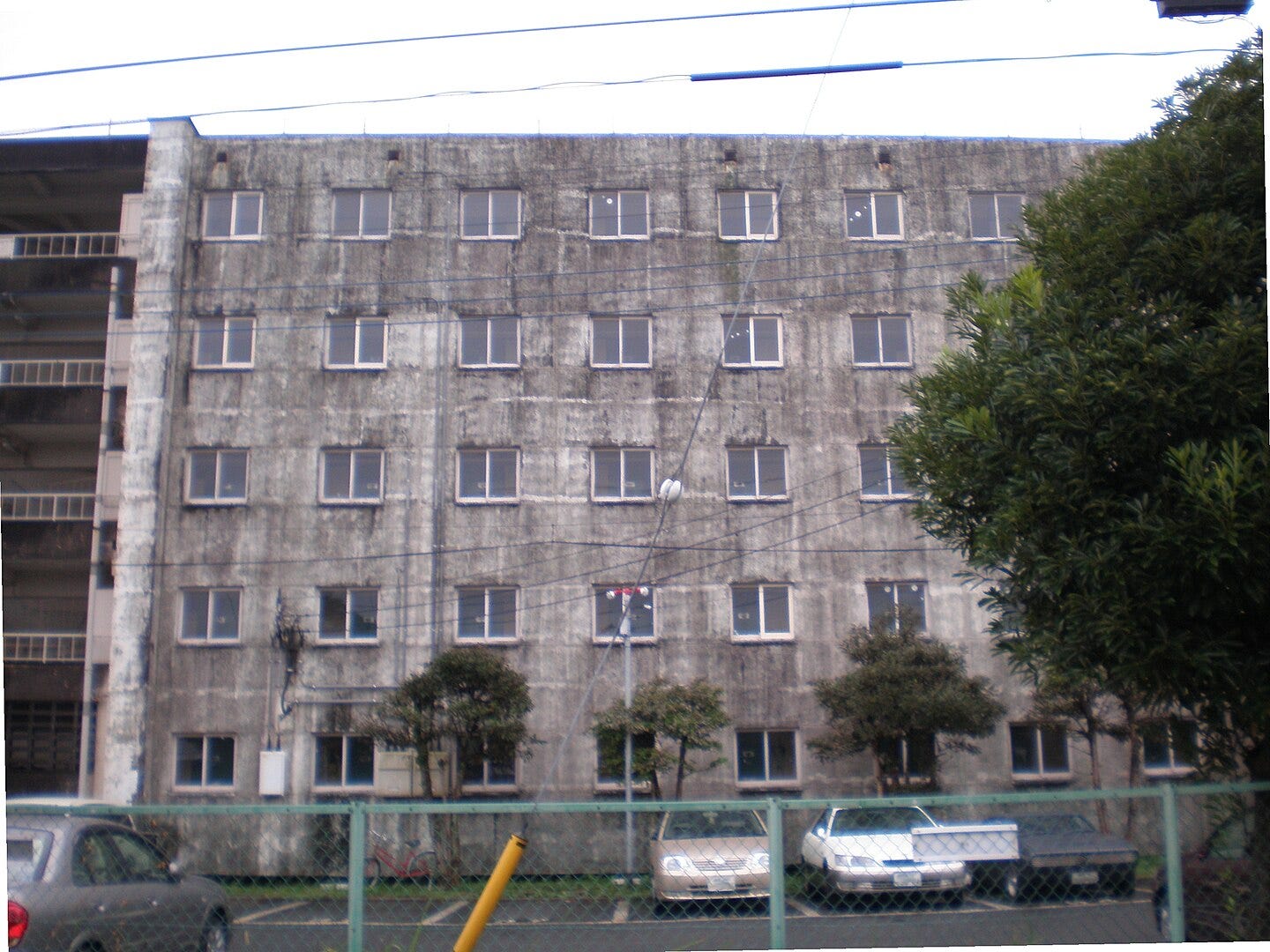
When I had looked at this hill from the elevated expressway the previous day, I could clearly see the reason for the trusty fat moniker — on the flat level plain on which Izumi City lies, this small broad hill is the only high ground available. In a country prone to typhoons and tsunamis, high ground is of great importance.
On the summit of Shinodayama there is an army base. But Japan doesn’t have an army; the soldiers guarding the base are civilians when they are off-duty. These soldiers were members of Japan’s Ground Self Defence Forces. Under the post World War Two constitution Japan was forbidden to have a military, but as the realities of the Cold War crept in and the US began to want Japan to shoulder some of the burden of defending itself, the constitution was interpreted to allow Japan to have forces for self-defence. Japan does not for example have any strategic bombers or attack aircraft as these would be considered offensive. But it does have fighters to intercept incoming enemy aircraft as these are considered defensive.
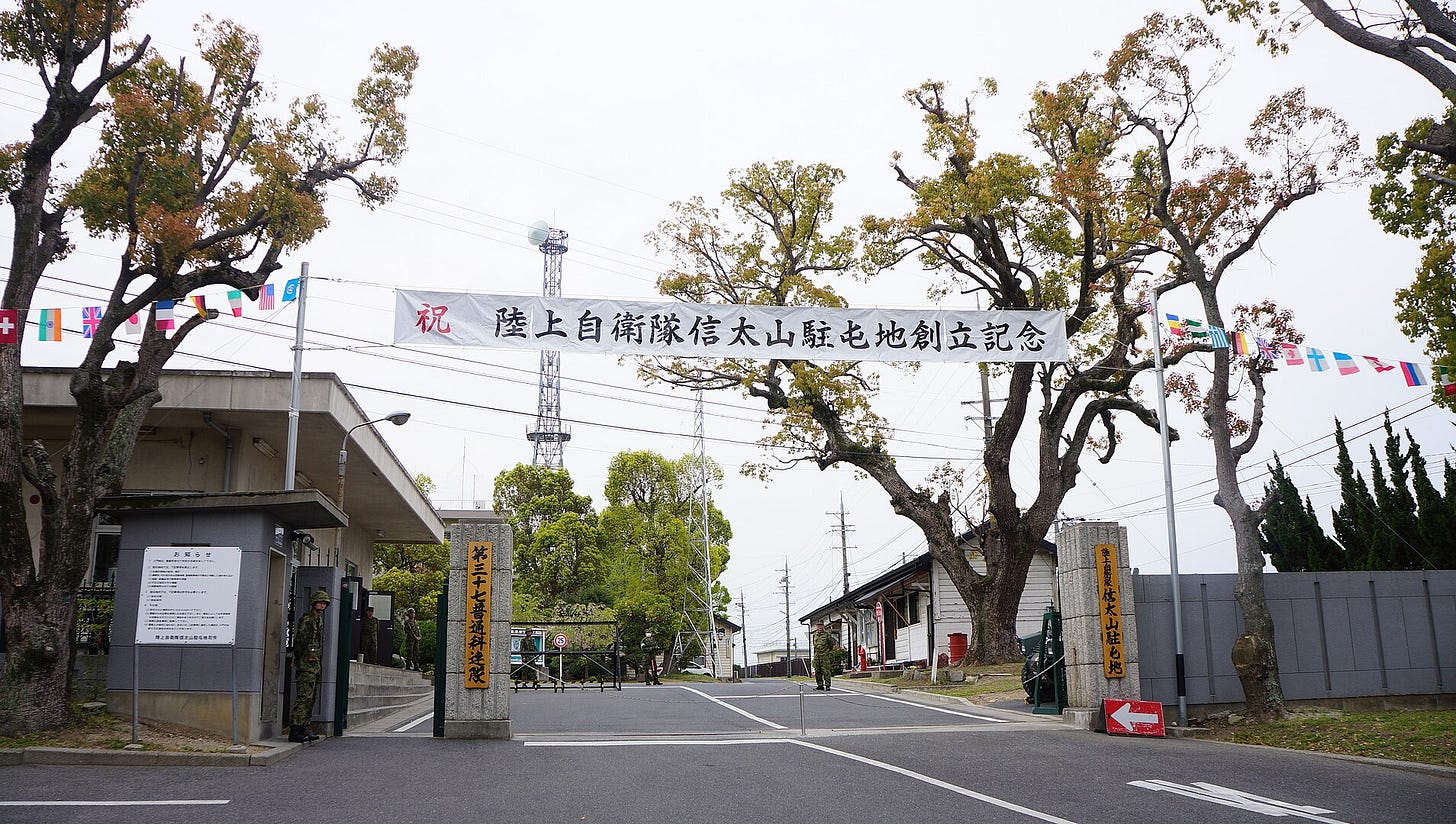
Behind the housing for the base personnel, I could make out some helicopters and a parade ground. Here, two crew members of a downed B-29 Superfortress, possibly one of those conducting the raids that produced the photos in Sakai Museum, were executed. Having taken off from Tinian in the Pacific on June 5th 1945, a huge flight of Superfortresses were on their way to attack the port city of Kobe when they were attacked by Japanese Tony fighter aircraft. One of the Superfortresses, the ‘Indian Maid’, was shot down – six of the crew bailed out and five went down with the aircraft. The gunners at the left and rear of the aircraft — Fitzgerald and Kennedy, were taken to the parade ground at Shinodayama around July 20th 1945 and executed.
From the militarized crest I dropped back down to the mundane realities of shopping centres and railway stations. Scorched and peeling vigorously, I made my way home.


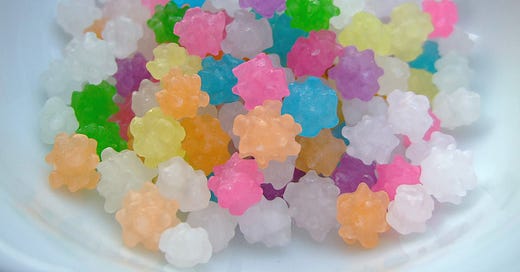


Julian, this was so enjoyable. There was so much to it -- I think I'll read it again later because I could hardly absorb all the delight. I restacked one description I liked, but I loved this one as well "old Japanese houses are tucked away in the centre of towns, surrounded by modern suburbs, like the red bean paste tucked away in the centre of the Japanese anpan bread" -- marvelous!
You write very well and I get a good impression of how it was for you to be in these. places. I have to go on these walks by reading your stories as I cant walk so far!